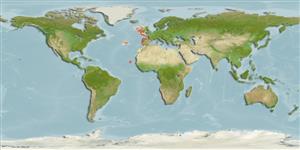Actinopterygii (ray-finned fishes) >
Gadiformes (Cods) >
Merlucciidae (Merluccid hakes) > Merlucciinae
Etymology: Lyconus: From Lykon, a Trojan warrior slain by Peneleus; mythology.
Environment / Climate / Range
Ecology
Marine; bathydemersal; depth range 150 - 997 m (Ref. 12204). Deep-water, preferred ?; 60°N - 30°S, 68°W - 14°E
Northwest Atlantic: off Canada. Northeast Atlantic: southwest of Ireland, Madeira, and off Saharian coasts (Ref. 6524).
Size / Weight / Age
Maturity: Lm ? range ? - ? cm
Max length : 52.5 cm SL male/unsexed; (Ref. 58452)
Short description
Morphology | Morphometrics
Rare species (Ref. 12204, 58452) found on the muddy slope of the continental shelf (Ref. 6524). Juveniles are captured from 150-700 m depth range (Ref. 58452). Biology unknown (Ref. 12204). Minimum depth reported taken from Ref. 58452.
Life cycle and mating behavior
Maturity | Reproduction | Spawning | Eggs | Fecundity | Larvae
Coad, B.W., 1995. Encyclopedia of Canadian fishes. Canadian Museum of Nature and Canadian Sportfishing Productions Inc. Singapore. (Ref. 12204)
IUCN Red List Status (Ref. 115185)
CITES (Ref. 94142)
Not Evaluated
Threat to humans
Harmless
Human uses
Fisheries: of no interest
More information
Common namesSynonymsMetabolismPredatorsEcotoxicologyReproductionMaturitySpawningFecundityEggsEgg development
Age/SizeGrowthLength-weightLength-lengthLength-frequenciesMorphometricsMorphologyLarvaeLarval dynamicsRecruitmentAbundance
ReferencesAquacultureAquaculture profileStrainsGeneticsAllele frequenciesHeritabilityDiseasesProcessingMass conversion
Tools
Special reports
Download XML
Internet sources
Estimates of some properties based on models
Phylogenetic diversity index (Ref.
82805): PD
50 = 0.7500 [Uniqueness, from 0.5 = low to 2.0 = high].
Bayesian length-weight: a=0.01000 (0.00244 - 0.04107), b=3.04 (2.81 - 3.27), in cm Total Length, based on all LWR estimates for this body shape (Ref.
93245).
Trophic Level (Ref.
69278): 4.2 ±0.6 se; Based on size and trophs of closest relatives
Resilience (Ref.
69278): Medium, minimum population doubling time 1.4 - 4.4 years (Assuming tmax>3).
Vulnerability (Ref.
59153): Moderate to high vulnerability (50 of 100) .
